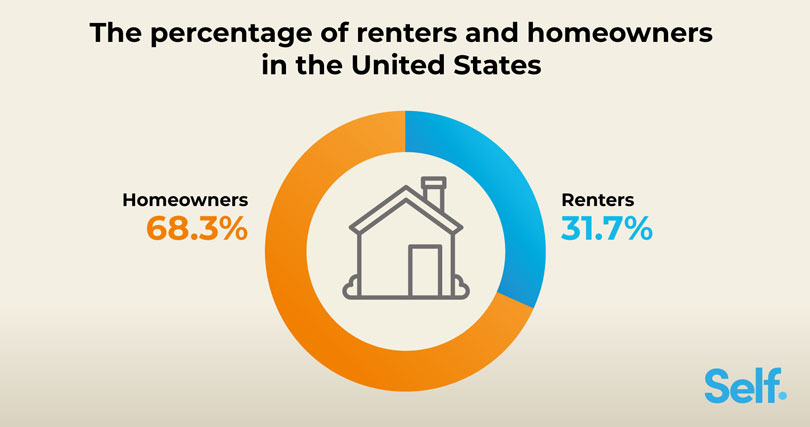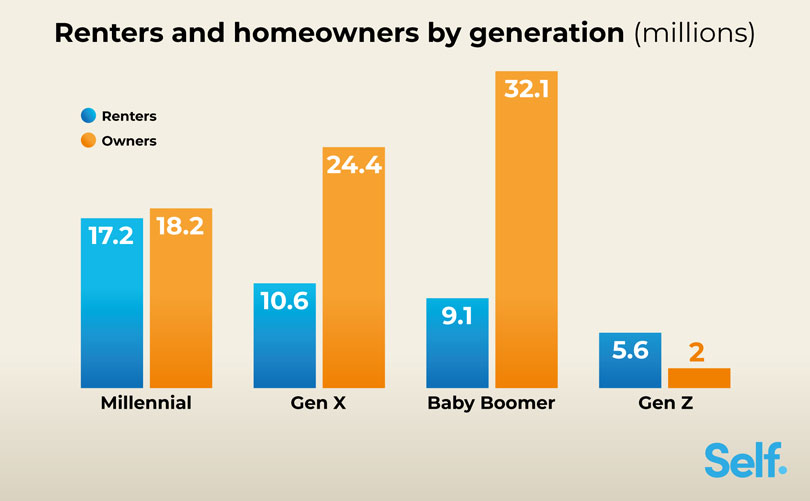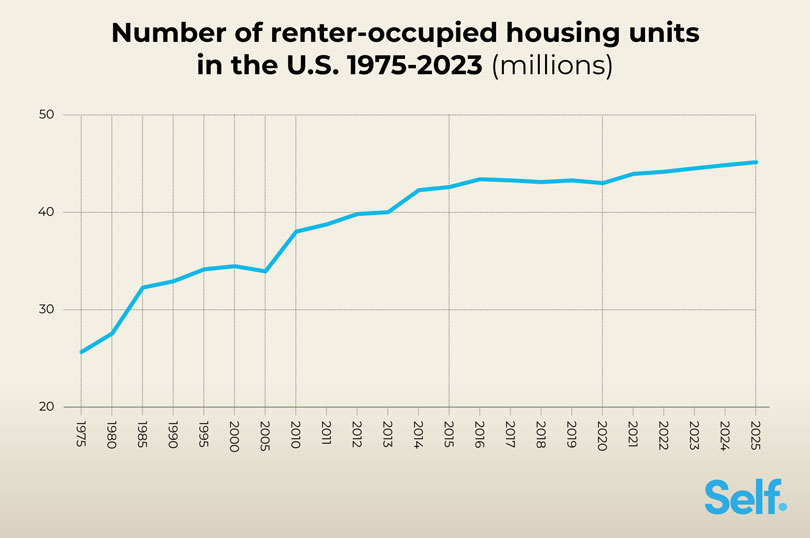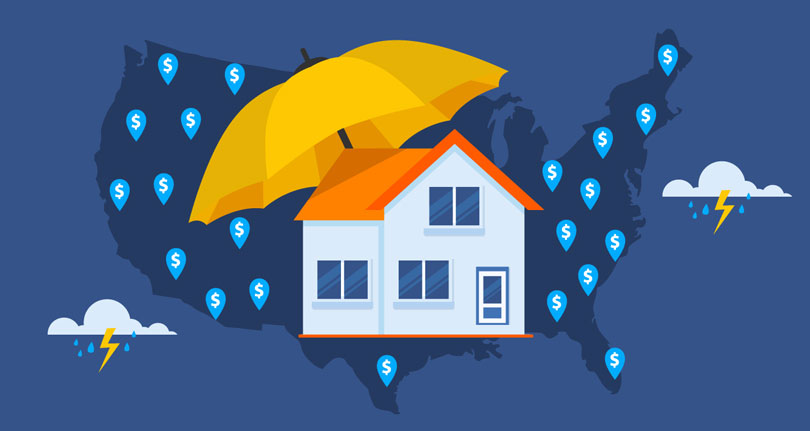There have been plenty of changes in the U.S. rental market over the past decade, but a review of U.S. rent statistics can help to provide a clear landscape of renting in the United States today.
This article offers a deep insight into key statistics on how many people rent, average rental costs, and how millennials and Gen Z fare in the current climate.
Key statistics
- Renters account for approximately 34% of the U.S. population, with 44 million housing units in the U.S. currently being rented.
- In the U.S. 17.2 million Millennials rent compared to 9.1 million baby boomers.
- Over 35% of people who are younger than 35 years of age are renting, compared to just 2.4% of people aged 85 and older.
- The average rental unit cost in the U.S. is $2,018.57 per month.
- A quarter (26%) of home-owned units have a household income of $150,000 or more, while 8.6% of renting households have an income at this level.
- 33.5% of the population were renting in 2014 compared to the 34.3% projected in 2023.
- There are over 102 million renters in the U.S. and 221 million homeowners.
- The most expensive U.S. city to rent in is Jackson, WY, with an average rent amount of $5,985.36 per month.
How many people rent in the U.S.?
According to our predictions based on the latest Census data, there could be over 109 million people renting homes in the U.S. as of 2023.
The last official figures collected were in 2021, when over 102 million renters were confirmed.
Almost 44 million housing units in the U.S. are renter-occupied, with just under 32% of households occupied by renters. [1] U.S. Census - Data Tables https://data.census.gov/table?q=total+number+of+renters&g=010XX00US&y=2014&d=ACS+1-Year+Supplemental+Estimates
Renters vs homeowners
There were over 102 million renters (31.7%) in the U.S. compared to 221 million homeowners (68.2%), according to the official 2021 figures.

The number of renters in the country has fluctuated year-on-year for the past six years, with 33.5% of people renting in 2014. Our projected figures for 2023 show that renter figures are on the rise again; according to the national data, 34.3% of the population could be leasing their home.
Renting a house or apartment offers significantly fewer initial costs and often comes with fewer running costs as landlords typically pay for the maintenance of the premises. Being a landlord or agent is also a time-consuming title - lots of time is spent renting out a home, 43% of homes for rent take 2-5 hours to screen new tenants per week when searching for a new renter. [2] Zillow - Typical U.S. Real Estate Investor https://www.zillow.com/research/typical-real-estate-investor-32497/
The identity of renters and homeowners
Renters and homeowners differ in identity. Generally, renters in America are younger and live on their own. While homeowners earn more and are over the age of 35.
Most owned housing units in the U.S. boast a household income of $150,000 or more, with 26% of homes bringing in this amount. It’s a stark contrast to renters, with just 8.6% of rented homes generating $150,000 and over. [1] U.S. Census - Data Tables https://data.census.gov/table?q=total+number+of+renters&g=010XX00US&y=2014&d=ACS+1-Year+Supplemental+Estimates
Despite the lower income in rented households, there are still plenty of costs attached to renting. According to the Zillow Observed Rent Index (ZORI) of all homes plus multifamily time index, rent has become more expensive every year since 2018 except in 2020, the average rent cost as of October 2023 is $2,018.57 per month. [3] Zippia - Data series: ZORI (smoothed): all homes plus multifamily time series ($) (Collected 10/31/2023) https://www.zillow.com/research/data/
Rent statistics by state in the U.S.
The state with the highest number of renter-occupied homes is Washington DC (58.9%), followed by New York (45.9%), and California (44.2%).
West Virginia has the highest percentage of owner-occupied housing units (74.4%), with Maine and Delaware both in second (74.1%).
Figures demonstrate the difference from one state to the next. Here are rent statistics by state:
| State |
Owner-occupied |
% owner-occupied |
Average household size of owner-occupied unit |
Renter-occupied |
% renter-occupied |
| State Alabama |
Owner-occupied 1,416,333 |
% owner-occupied 70.2% |
Average household size of owner-occupied unit 2.54 |
Renter-occupied 600,115 |
% renter-occupied 29.8% |
| State Alaska |
Owner-occupied 181,586 |
% owner-occupied 66.1% |
Average household size of owner-occupied unit 2.69 |
Renter-occupied 92,988 |
% renter-occupied 33.9% |
| State Arizona |
Owner-occupied 1,921,746 |
% owner-occupied 67.4% |
Average household size of owner-occupied unit 2.59 |
Renter-occupied 928,631 |
% renter-occupied 32.6% |
| State Arkansas |
Owner-occupied 808,558 |
% owner-occupied 66.5% |
Average household size of owner-occupied unit 2.56 |
Renter-occupied 407,649 |
% renter-occupied 33.5% |
| State California |
Owner-occupied 7,565,502 |
% owner-occupied 55.8% |
Average household size of owner-occupied unit 2.94 |
Renter-occupied 5,985,084 |
% renter-occupied 44.2% |
| State Colorado |
Owner-occupied 1,584,309 |
% owner-occupied 66.4% |
Average household size of owner-occupied unit 2.54 |
Renter-occupied 800,275 |
% renter-occupied 33.6% |
| State Connecticut |
Owner-occupied 949,839 |
% owner-occupied 66.3% |
Average household size of owner-occupied unit 2.62 |
Renter-occupied 483,796 |
% renter-occupied 33.7% |
| State Delaware |
Owner-occupied 298,075 |
% owner-occupied 74.1% |
Average household size of owner-occupied unit 2.51 |
Renter-occupied 104,259 |
% renter-occupied 25.9% |
| State District of Columbia |
Owner-occupied 134,120 |
% owner-occupied 41.0% |
Average household size of owner-occupied unit 2.1 |
Renter-occupied 192,850 |
% renter-occupied 59.0% |
| State Florida |
Owner-occupied 5,929,801 |
% owner-occupied 67.2% |
Average household size of owner-occupied unit 2.51 |
Renter-occupied 2,896,593 |
% renter-occupied 32.8% |
| State Georgia |
Owner-occupied 2,695,885 |
% owner-occupied 65.9% |
Average household size of owner-occupied unit 2.71 |
Renter-occupied 1,396,582 |
% renter-occupied 34.1% |
| State Hawaii |
Owner-occupied 309,687 |
% owner-occupied 62.6% |
Average household size of owner-occupied unit 2.92 |
Renter-occupied 185,140 |
% renter-occupied 37.4% |
| State Idaho |
Owner-occupied 518,837 |
% owner-occupied 72.3% |
Average household size of owner-occupied unit 2.7 |
Renter-occupied 198,314 |
% renter-occupied 27.7% |
| State Illinois |
Owner-occupied 3,392,312 |
% owner-occupied 67.1% |
Average household size of owner-occupied unit 2.6 |
Renter-occupied 1,664,048 |
% renter-occupied 32.9% |
| State Indiana |
Owner-occupied 1,929,865 |
% owner-occupied 70.8% |
Average household size of owner-occupied unit 2.56 |
Renter-occupied 796,624 |
% renter-occupied 29.2% |
| State Iowa |
Owner-occupied 958,700 |
% owner-occupied 72.0% |
Average household size of owner-occupied unit 2.47 |
Renter-occupied 372,295 |
% renter-occupied 28.0% |
| State Kansas |
Owner-occupied 795,989 |
% owner-occupied 67.7% |
Average household size of owner-occupied unit 2.57 |
Renter-occupied 379,305 |
% renter-occupied 32.3% |
| State Kentucky |
Owner-occupied 1,257,737 |
% owner-occupied 68.8% |
Average household size of owner-occupied unit 2.5 |
Renter-occupied 570,943 |
% renter-occupied 31.2% |
| State Louisiana |
Owner-occupied 1,229,012 |
% owner-occupied 67.6% |
Average household size of owner-occupied unit 2.55 |
Renter-occupied 587,890 |
% renter-occupied 32.4% |
| State Maine |
Owner-occupied 448,772 |
% owner-occupied 74.1% |
Average household size of owner-occupied unit 2.33 |
Renter-occupied 156,566 |
% renter-occupied 25.9% |
| State Maryland |
Owner-occupied 1,609,588 |
% owner-occupied 67.7% |
Average household size of owner-occupied unit 2.67 |
Renter-occupied 766,396 |
% renter-occupied 32.3% |
| State Massachusetts |
Owner-occupied 1,741,555 |
% owner-occupied 62.2% |
Average household size of owner-occupied unit 2.61 |
Renter-occupied 1,056,221 |
% renter-occupied 37.8% |
| State Michigan |
Owner-occupied 2,991,685 |
% owner-occupied 73.2% |
Average household size of owner-occupied unit 2.52 |
Renter-occupied 1,098,109 |
% renter-occupied 26.8% |
| State Minnesota |
Owner-occupied 1,674,434 |
% owner-occupied 72.1% |
Average household size of owner-occupied unit 2.57 |
Renter-occupied 647,756 |
% renter-occupied 27.9% |
| State Mississippi |
Owner-occupied 803,006 |
% owner-occupied 69.9% |
Average household size of owner-occupied unit 2.52 |
Renter-occupied 345,334 |
% renter-occupied 30.1% |
| State Missouri |
Owner-occupied 1,704,800 |
% owner-occupied 67.6% |
Average household size of owner-occupied unit 2.54 |
Renter-occupied 817,032 |
% renter-occupied 32.4% |
| State Montana |
Owner-occupied 319,421 |
% owner-occupied 68.8% |
Average household size of owner-occupied unit 2.48 |
Renter-occupied 144,651 |
% renter-occupied 31.2% |
| State Nebraska |
Owner-occupied 529,723 |
% owner-occupied 66.0% |
Average household size of owner-occupied unit 2.58 |
Renter-occupied 273,434 |
% renter-occupied 34.0% |
| State Nevada |
Owner-occupied 722,684 |
% owner-occupied 60.3% |
Average household size of owner-occupied unit 2.69 |
Renter-occupied 475,672 |
% renter-occupied 39.7% |
| State New Hampshire |
Owner-occupied 402,656 |
% owner-occupied 72.3% |
Average household size of owner-occupied unit 2.58 |
Renter-occupied 154,564 |
% renter-occupied 27.7% |
| State New Jersey |
Owner-occupied 2,272,995 |
% owner-occupied 64.6% |
Average household size of owner-occupied unit 2.73 |
Renter-occupied 1,243,983 |
% renter-occupied 35.4% |
| State New Mexico |
Owner-occupied 601,666 |
% owner-occupied 70.9% |
Average household size of owner-occupied unit 2.55 |
Renter-occupied 246,552 |
% renter-occupied 29.1% |
| State New York |
Owner-occupied 4,204,337 |
% owner-occupied 54.1% |
Average household size of owner-occupied unit 2.64 |
Renter-occupied 3,569,971 |
% renter-occupied 45.9% |
| State North Carolina |
Owner-occupied 2,868,467 |
% owner-occupied 66.7% |
Average household size of owner-occupied unit 2.53 |
Renter-occupied 1,430,799 |
% renter-occupied 33.3% |
| State North Dakota |
Owner-occupied 215,896 |
% owner-occupied 65.1% |
Average household size of owner-occupied unit 2.42 |
Renter-occupied 115,585 |
% renter-occupied 34.9% |
| State Ohio |
Owner-occupied 3,285,052 |
% owner-occupied 67.3% |
Average household size of owner-occupied unit 2.49 |
Renter-occupied 1,593,154 |
% renter-occupied 32.7% |
| State Oklahoma |
Owner-occupied 1,029,003 |
% owner-occupied 65.4% |
Average household size of owner-occupied unit 2.58 |
Renter-occupied 544,177 |
% renter-occupied 34.6% |
| State Oregon |
Owner-occupied 1,084,786 |
% owner-occupied 62.8% |
Average household size of owner-occupied unit 2.52 |
Renter-occupied 641,554 |
% renter-occupied 37.2% |
| State Pennsylvania |
Owner-occupied 3,658,207 |
% owner-occupied 69.1% |
Average household size of owner-occupied unit 2.52 |
Renter-occupied 1,635,858 |
% renter-occupied 30.9% |
| State Puerto Rico |
Owner-occupied 869,635 |
% owner-occupied 67.4% |
Average household size of owner-occupied unit 2.53 |
Renter-occupied 419,676 |
% renter-occupied 32.6% |
| State Rhode Island |
Owner-occupied 282,617 |
% owner-occupied 63.3% |
Average household size of owner-occupied unit 2.54 |
Renter-occupied 164,071 |
% renter-occupied 36.7% |
| State South Carolina |
Owner-occupied 1,538,550 |
% owner-occupied 72.0% |
Average household size of owner-occupied unit 2.48 |
Renter-occupied 597,530 |
% renter-occupied 28.0% |
| State South Dakota |
Owner-occupied 256,326 |
% owner-occupied 69.6% |
Average household size of owner-occupied unit 2.53 |
Renter-occupied 111,974 |
% renter-occupied 30.4% |
| State Tennessee |
Owner-occupied 1,914,030 |
% owner-occupied 67.2% |
Average household size of owner-occupied unit 2.51 |
Renter-occupied 932,654 |
% renter-occupied 32.8% |
| State Texas |
Owner-occupied 6,926,616 |
% owner-occupied 62.5% |
Average household size of owner-occupied unit 2.85 |
Renter-occupied 4,161,092 |
% renter-occupied 37.5% |
| State United States |
Owner-occupied 84,649,084 |
% owner-occupied 65.2% |
Average household size of owner-occupied unit 2.63 |
Renter-occupied 45,221,844 |
% renter-occupied 34.8% |
| State Utah |
Owner-occupied 804,164 |
% owner-occupied 71.2% |
Average household size of owner-occupied unit 3.12 |
Renter-occupied 325,496 |
% renter-occupied 28.8% |
| State Vermont |
Owner-occupied 204,089 |
% owner-occupied 73.7% |
Average household size of owner-occupied unit 2.41 |
Renter-occupied 73,001 |
% renter-occupied 26.3% |
| State Virginia |
Owner-occupied 2,278,062 |
% owner-occupied 67.4% |
Average household size of owner-occupied unit 2.6 |
Renter-occupied 1,102,545 |
% renter-occupied 32.6% |
| State Washington |
Owner-occupied 1,976,259 |
% owner-occupied 64.2% |
Average household size of owner-occupied unit 2.64 |
Renter-occupied 1,103,694 |
% renter-occupied 35.8% |
| State West Virginia |
Owner-occupied 548,389 |
% owner-occupied 74.5% |
Average household size of owner-occupied unit 2.4 |
Renter-occupied 187,952 |
% renter-occupied 25.5% |
| State Wisconsin |
Owner-occupied 1,696,493 |
% owner-occupied 68.1% |
Average household size of owner-occupied unit 2.47 |
Renter-occupied 794,628 |
% renter-occupied 31.9% |
| State Wyoming |
Owner-occupied 176,863 |
% owner-occupied 72.7% |
Average household size of owner-occupied unit 2.45 |
Renter-occupied 66,458 |
% renter-occupied 27.3% |
Source [1] U.S. Census - Data Tables https://data.census.gov/table?q=total+number+of+renters&g=010XX00US&y=2014&d=ACS+1-Year+Supplemental+Estimates
Demographics of renters in the U.S
Based on official figures from the U.S. Census, the predominant renter (by percentage) is of white ethnicity, under 35 years of age, has a college education and has a household income of between $35,000 to $49,999.
Renters and homeowners by household income:
Let's take a closer look at the income of renters and homeowners.
| Household income (past 12 months) |
Occupied housing units |
Percent occupied housing units |
Owner-occupied housing units |
% |
Renter-occupied housing units |
% |
| Household income (past 12 months) Less than $5,000 |
Occupied housing units 4,470,961 |
Percent occupied housing units 3.4% |
Owner-occupied housing units 1,810,658 |
% 2.1% |
Renter-occupied housing units 2,660,303 |
% 5.9% |
| Household income (past 12 months) $5,000 to $9,999 |
Occupied housing units 2,648,593 |
Percent occupied housing units 2.0% |
Owner-occupied housing units 1,023,466 |
% 1.2% |
Renter-occupied housing units 1,625,127 |
% 3.6% |
| Household income (past 12 months) $10,000 to $14,999 |
Occupied housing units 4,835,372 |
Percent occupied housing units 3.7% |
Owner-occupied housing units 1,797,463 |
% 2.1% |
Renter-occupied housing units 3,037,909 |
% 6.7% |
| Household income (past 12 months) $15,000 to $19,999 |
Occupied housing units 4,199,024 |
Percent occupied housing units 3.2% |
Owner-occupied housing units 1,916,740 |
% 2.3% |
Renter-occupied housing units 2,282,284 |
% 5.0% |
| Household income (past 12 months) $20,000 to $24,999 |
Occupied housing units 4,613,942 |
Percent occupied housing units 3.6% |
Owner-occupied housing units 2,226,603 |
% 2.6% |
Renter-occupied housing units 2,387,339 |
% 5.3% |
| Household income (past 12 months) $25,000 to $34,999 |
Occupied housing units 9,425,048 |
Percent occupied housing units 7.3% |
Owner-occupied housing units 4,753,120 |
% 5.6% |
Renter-occupied housing units 4,671,928 |
% 10.3% |
| Household income (past 12 months) $35,000 to $49,999 |
Occupied housing units 13,834,348 |
Percent occupied housing units 10.7% |
Owner-occupied housing units 7,603,722 |
% 9.0% |
Renter-occupied housing units 6,230,626 |
% 13.8% |
| Household income (past 12 months) $50,000 to $74,999 |
Occupied housing units 21,096,082 |
Percent occupied housing units 16.2% |
Owner-occupied housing units 12,980,433 |
% 15.3% |
Renter-occupied housing units 8,115,649 |
% 17.9% |
| Household income (past 12 months) $75,000 to $99,999 |
Occupied housing units 16,650,769 |
Percent occupied housing units 12.8% |
Owner-occupied housing units 11,451,098 |
% 13.5% |
Renter-occupied housing units 5,199,671 |
% 11.5% |
| Household income (past 12 months) $100,000 to $149,999 |
Occupied housing units 21,945,002 |
Percent occupied housing units 16.9% |
Owner-occupied housing units 16,826,281 |
% 19.9% |
Renter-occupied housing units 5,118,721 |
% 11.3% |
| Household income (past 12 months) $150,000 or more |
Occupied housing units 26,151,787 |
Percent occupied housing units 20.1% |
Owner-occupied housing units 22,259,500 |
% 26.3% |
Renter-occupied housing units 3,892,287 |
% 8.6% |
Source [1] U.S. Census - Data Tables https://data.census.gov/table?q=total+number+of+renters&g=010XX00US&y=2014&d=ACS+1-Year+Supplemental+Estimates
Renters and homeowners by age group
The majority of homeowners are aged between 55 and 64 years while most renters are younger than 35.
| Age of householder |
Occupied housing units |
Percent occupied housing units |
Owner-occupied housing units |
% |
Renter-occupied housing units |
% |
| Age of householder Under 35 years |
Occupied housing units 25,290,195 |
Percent occupied housing units 19.50% |
Owner-occupied housing units 9,248,112 |
% 10.90% |
Renter-occupied housing units 16,042,083 |
% 35.50% |
| Age of householder 35 to 44 years |
Occupied housing units 22,819,278 |
Percent occupied housing units 17.60% |
Owner-occupied housing units 13,953,744 |
% 16.50% |
Renter-occupied housing units 8,865,534 |
% 19.60% |
| Age of householder 45 to 54 years |
Occupied housing units 22,102,505 |
Percent occupied housing units 17.00% |
Owner-occupied housing units 15,450,457 |
% 18.30% |
Renter-occupied housing units 6,652,048 |
% 14.70% |
| Age of householder 55 to 64 years |
Occupied housing units 24,180,302 |
Percent occupied housing units 18.60% |
Owner-occupied housing units 18,198,247 |
% 21.50% |
Renter-occupied housing units 5,982,055 |
% 13.20% |
| Age of householder 65 to 74 years |
Occupied housing units 20,536,818 |
Percent occupied housing units 15.80% |
Owner-occupied housing units 16,246,323 |
% 19.20% |
Renter-occupied housing units 4,290,495 |
% 9.50% |
| Age of householder 75 to 84 years |
Occupied housing units 11,107,795 |
Percent occupied housing units 8.60% |
Owner-occupied housing units 8,811,391 |
% 10.40% |
Renter-occupied housing units 2,296,404 |
% 5.10% |
| Age of householder 85 years and over |
Occupied housing units 3,834,035 |
Percent occupied housing units 3.00% |
Owner-occupied housing units 2,740,810 |
% 3.20% |
Renter-occupied housing units 1,093,225 |
% 2.40% |
Source [1] U.S. Census - Data Tables https://data.census.gov/table?q=total+number+of+renters&g=010XX00US&y=2014&d=ACS+1-Year+Supplemental+Estimates
Younger boomers (aged 55-64) are the generation reaping the rewards of being on the property ladder - but Gen Z are only accountable for 3-4% of buyers and sellers.
When looking at how many millennials rent, statistics show that millennials are the biggest population of renters; recent 2022 figures revealed that 17.2 million millennials are currently renting.
Here’s a look at the different generations and how many own or rent.

Source [4] Rent Cafe - Millennials Make Historic Switch from Renter to Owner Majority https://www.rentcafe.com/blog/rental-market/market-snapshots/millennials-switch-renter-to-owner-majority/
As of 2022, Richmond, WY had the biggest percentage per population of millennial renters (84.50%). [4] Rent Cafe - Millennials Make Historic Switch from Renter to Owner Majority https://www.rentcafe.com/blog/rental-market/market-snapshots/millennials-switch-renter-to-owner-majority/
It’s no secret that millennials and Gen Z are finding it more difficult to get onto the property ladder. There can be a number of reasons for this, with prices increasing and the economy changing.
The size of an average renting household by state
The average size of a renting household in the United States is 2.27 - with the highest average size being 2.61 in California and the lowest - 1.78 in Vermont.
Take a look at the official data for the average household size below:
| State |
Total renter-occupied |
% renter occupied |
Average household size of renter-occupied unit |
| State Alabama |
Total renter-occupied 600,115 |
% renter occupied 29.76% |
Average household size of renter-occupied unit 2.22 |
| State Alaska |
Total renter-occupied 92,988 |
% renter occupied 33.87% |
Average household size of renter-occupied unit 2.31 |
| State Arizona |
Total renter-occupied 928,631 |
% renter occupied 32.58% |
Average household size of renter-occupied unit 2.39 |
| State Arkansas |
Total renter-occupied 407,649 |
% renter occupied 33.52% |
Average household size of renter-occupied unit 2.2 |
| State California |
Total renter-occupied 5,985,084 |
% renter occupied 44.17% |
Average household size of renter-occupied unit 2.66 |
| State Colorado |
Total renter-occupied 800,275 |
% renter occupied 33.56% |
Average household size of renter-occupied unit 2.12 |
| State Connecticut |
Total renter-occupied 483,796 |
% renter occupied 33.75% |
Average household size of renter-occupied unit 2.1 |
| State Delaware |
Total renter-occupied 104,259 |
% renter occupied 25.91% |
Average household size of renter-occupied unit 2.37 |
| State District of Columbia |
Total renter-occupied 192,850 |
% renter occupied 58.98% |
Average household size of renter-occupied unit 1.82 |
| State Florida |
Total renter-occupied 2,896,593 |
% renter occupied 32.82% |
Average household size of renter-occupied unit 2.39 |
| State Georgia |
Total renter-occupied 1,396,582 |
% renter occupied 34.13% |
Average household size of renter-occupied unit 2.41 |
| State Hawaii |
Total renter-occupied 185,140 |
% renter occupied 37.42% |
Average household size of renter-occupied unit 2.67 |
| State Idaho |
Total renter-occupied 198,314 |
% renter occupied 27.65% |
Average household size of renter-occupied unit 2.46 |
| State Illinois |
Total renter-occupied 1,664,048 |
% renter occupied 32.91% |
Average household size of renter-occupied unit 2.09 |
| State Indiana |
Total renter-occupied 796,624 |
% renter occupied 29.22% |
Average household size of renter-occupied unit 2.14 |
| State Iowa |
Total renter-occupied 372,295 |
% renter occupied 27.97% |
Average household size of renter-occupied unit 1.96 |
| State Kansas |
Total renter-occupied 379,305 |
% renter occupied 32.27% |
Average household size of renter-occupied unit 2.12 |
| State Kentucky |
Total renter-occupied 570,943 |
% renter occupied 31.22% |
Average household size of renter-occupied unit 2.18 |
| State Louisiana |
Total renter-occupied 587,890 |
% renter occupied 32.36% |
Average household size of renter-occupied unit 2.26 |
| State Maine |
Total renter-occupied 156,566 |
% renter occupied 25.86% |
Average household size of renter-occupied unit 1.92 |
| State Maryland |
Total renter-occupied 766,396 |
% renter occupied 32.26% |
Average household size of renter-occupied unit 2.26 |
| State Massachusetts |
Total renter-occupied 1,056,221 |
% renter occupied 37.75% |
Average household size of renter-occupied unit 2.08 |
| State Michigan |
Total renter-occupied 1,098,109 |
% renter occupied 26.85% |
Average household size of renter-occupied unit 2.08 |
| State Minnesota |
Total renter-occupied 647,756 |
% renter occupied 27.89% |
Average household size of renter-occupied unit 1.98 |
| State Mississippi |
Total renter-occupied 345,334 |
% renter occupied 30.07% |
Average household size of renter-occupied unit 2.38 |
| State Missouri |
Total renter-occupied 817,032 |
% renter occupied 32.40% |
Average household size of renter-occupied unit 2.06 |
| State Montana |
Total renter-occupied 144,651 |
% renter occupied 31.17% |
Average household size of renter-occupied unit 2.07 |
| State Nebraska |
Total renter-occupied 273,434 |
% renter occupied 34.04% |
Average household size of renter-occupied unit 2.03 |
| State Nevada |
Total renter-occupied 475,672 |
% renter occupied 39.69% |
Average household size of renter-occupied unit 2.53 |
| State New Hampshire |
Total renter-occupied 154,564 |
% renter occupied 27.74% |
Average household size of renter-occupied unit 2.08 |
| State New Jersey |
Total renter-occupied 1,243,983 |
% renter occupied 35.37% |
Average household size of renter-occupied unit 2.33 |
| State New Mexico |
Total renter-occupied 246,552 |
% renter occupied 29.07% |
Average household size of renter-occupied unit 2.17 |
| State New York |
Total renter-occupied 3,569,971 |
% renter occupied 45.92% |
Average household size of renter-occupied unit 2.23 |
| State North Carolina |
Total renter-occupied 1,430,799 |
% renter occupied 33.28% |
Average household size of renter-occupied unit 2.2 |
| State North Dakota |
Total renter-occupied 115,585 |
% renter occupied 34.87% |
Average household size of renter-occupied unit 1.96 |
| State Ohio |
Total renter-occupied 1,593,154 |
% renter occupied 32.66% |
Average household size of renter-occupied unit 2.06 |
| State Oklahoma |
Total renter-occupied 544,177 |
% renter occupied 34.59% |
Average household size of renter-occupied unit 2.3 |
| State Oregon |
Total renter-occupied 641,554 |
% renter occupied 37.16% |
Average household size of renter-occupied unit 2.19 |
| State Pennsylvania |
Total renter-occupied 1,635,858 |
% renter occupied 30.90% |
Average household size of renter-occupied unit 2.03 |
| State Puerto Rico |
Total renter-occupied 419,676 |
% renter occupied 32.55% |
Average household size of renter-occupied unit 2.35 |
| State Rhode Island |
Total renter-occupied 164,071 |
% renter occupied 36.73% |
Average household size of renter-occupied unit 2.01 |
| State South Carolina |
Total renter-occupied 597,530 |
% renter occupied 27.97% |
Average household size of renter-occupied unit 2.22 |
| State South Dakota |
Total renter-occupied 111,974 |
% renter occupied 30.40% |
Average household size of renter-occupied unit 2.05 |
| State Tennessee |
Total renter-occupied 932,654 |
% renter occupied 32.76% |
Average household size of renter-occupied unit 2.26 |
| State Texas |
Total renter-occupied 4,161,092 |
% renter occupied 37.53% |
Average household size of renter-occupied unit 2.33 |
| State United States |
Total renter-occupied 45,221,844 |
% renter occupied 34.82% |
Average household size of renter-occupied unit 2.27 |
| State Utah |
Total renter-occupied 325,496 |
% renter occupied 28.81% |
Average household size of renter-occupied unit 2.52 |
| State Vermont |
Total renter-occupied 73,001 |
% renter occupied 26.35% |
Average household size of renter-occupied unit 1.78 |
| State Virginia |
Total renter-occupied 1,102,545 |
% renter occupied 32.61% |
Average household size of renter-occupied unit 2.28 |
| State Washington |
Total renter-occupied 1,103,694 |
% renter occupied 35.83% |
Average household size of renter-occupied unit 2.19 |
| State West Virginia |
Total renter-occupied 187,952 |
% renter occupied 25.53% |
Average household size of renter-occupied unit 2.16 |
| State Wisconsin |
Total renter-occupied 794,628 |
% renter occupied 31.90% |
Average household size of renter-occupied unit 1.97 |
| State Wyoming |
Total renter-occupied 66,458 |
% renter occupied 27.31% |
Average household size of renter-occupied unit 2.03 |
Interestingly, statistics change between cities with different correlations and patterns, this applies to more than house sizes.
The most expensive U.S. city to rent in is Jackson, WY, with an average rent amount of $5985.36. [3] Zippia - Data series: ZORI (smoothed): all homes plus multifamily time series ($) (Collected 10/31/2023) https://www.zillow.com/research/data/
Half of the renters in Wisconsin are on a month-to-month contract. Florida is positioned on the other end of the spectrum, with just 10% of their residents on a month-to-month agreement. [5] Statista - Housing Units Occupied by Renters in the U.S. Since 1975 https://www.statista.com/statistics/187577/housing-units-occupied-by-renter-in-the-us-since-1975/
Change in the number of renter-occupied homes over time
There’s been a remarkable rise in renters since 1975, from 25.6 million to today’s predicted 44.5 million.
The data reflects the economic climate with many millennials and Gen Z struggling to dip their toe into the real estate market.

Source [5] Statista - Housing Units Occupied by Renters in the U.S. Since 1975 https://www.statista.com/statistics/187577/housing-units-occupied-by-renter-in-the-us-since-1975/
Data note: 2023-2025 is predicted based on trends.
The most common types of rental property
There’s no shortage of properties to rent with apartments, townhouses and even opportunities for businesses to rent commercial property.
Here is a list of the different types of properties to rent:
- Duplexes
- Condo
- Townhouse
- Vacation Homes
- Apartments
- Commercial Properties
- Single Family Homes
- Getaway Homes
The most common rental type is an apartment or condo in a smaller building.
According to a survey conducted by Zillow, in 2022 most renters (55%) lived in an apartment building. The typical rental home has 2 bedrooms and 1.5 bathrooms and is 1000 – 1999 square feet (500-999 for recent renters). [6] Zillow - Renters: Consumer Housing Trends Report https://www.zillow.com/research/renters-consumer-housing-trends-report-2022-31265/
Rental properties by landlord type
A study conducted by Zillow in February 2023 asked questions to more than 1,000 people who own at least one property that they rent out. The results of the survey found the following.
For landlords who only rent out a single property, the most common unit type is a single-family detached house (66%), followed by an apartment or condo in a smaller-sized building (10%).
Semi-detached houses are also most common for landlords who rent out multiple properties (41%), with apartments or condos in small buildings (24%), and duplex or triplex apartments (23%) also common.
| Type of property/properties rented out |
Landlords who rent out one property |
Landlords who rent out multiple properties |
| Type of property/properties rented out Apartment / Condo in a smaller size building (fewer than 10 units) |
Landlords who rent out one property 10% |
Landlords who rent out multiple properties 24% |
| Type of property/properties rented out Apartment / Condo in a medium size building (10-49 units) |
Landlords who rent out one property 5% |
Landlords who rent out multiple properties 16% |
| Type of property/properties rented out Apartment / Condo in a larger size building (50 units or more) |
Landlords who rent out one property 4% |
Landlords who rent out multiple properties 12% |
| Type of property/properties rented out Duplex / Triplex |
Landlords who rent out one property 6% |
Landlords who rent out multiple properties 23% |
| Type of property/properties rented out Manufactured / mobile home |
Landlords who rent out one property 5% |
Landlords who rent out multiple properties 5% |
| Type of property/properties rented out Single-family detached house |
Landlords who rent out one property 66% |
Landlords who rent out multiple properties 41% |
| Type of property/properties rented out Townhouse / rowhouse |
Landlords who rent out one property 3% |
Landlords who rent out multiple properties 13% |
Lengths of rental leases
As of 2022, the most common length of rental is 12 months with 59.6% of rental leases being this length. [7] BLS: Housing Leases in the U.S. Rental Market https://www.bls.gov/spotlight/2022/housing-leases-in-the-u-s-rental-market/home.htm
Aside from 12-month leases, the next most common lease length is 24-months, with 29.9% of other lease agreements being signed for 24 months.
| Other lease lengths(not including 12 months) |
Percentage of leases |
| 24 months |
29.9% |
| 13 months |
14.8% |
| 6 months |
12.4% |
| 15 months |
9.6% |
| 14 months |
7% |
| 10 months |
3.9% |
| Other length |
22.5% |
New tenants have increased by 76.4%, portraying renters moving home or people recently joining the market as a renter. [7] BLS: Housing Leases in the U.S. Rental Market https://www.bls.gov/spotlight/2022/housing-leases-in-the-u-s-rental-market/home.htm
Rental vacancy rates
The rental vacancy rate has increased in 2023 with a rise of 0.6 percentage points in the first quarter and a further 0.1 percentage point in the second quarter. [8] U.S. Census - Quarterly Residential Vacancies and Homeownership https://www.census.gov/housing/hvs/files/currenthvspress.pdf
This means that there are more empty apartments and other rentals this year compared to the previous year. There are fewer housing units and other types of rental properties occupied compared to last year, but when dating back to 2018-2021, this year’s figures are not unusual.
Here’s a full take on the rental vacancy rate statistics:
Rental Vacancy Rate (percent)
| Year |
Q1 |
Q2 |
Q3 |
Q4 |
| 2023 |
6.4% |
6.3% |
6.6% |
- |
| 2022 |
5.8% |
5.6% |
6% |
5.8% |
| 2021 |
6.8% |
6.2% |
5.8% |
5.6% |
| 2020 |
6.6% |
5.7% |
6.4% |
6.5% |
| 2019 |
7% |
6.8% |
6.8% |
6.4% |
| 2018 |
7% |
6.8% |
7.1% |
6.6% |
Sources









